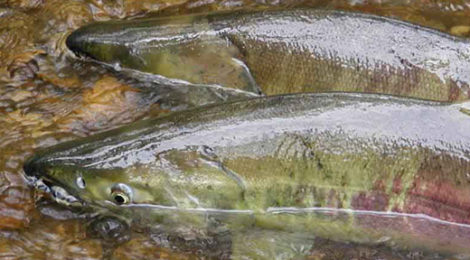
North Pacific Chum Salmon Returns Absolutely Dismal
Alaska scientists report just 15% of Chum survived their 5 years at sea to return home to spawn
Chum salmon have been experiencing a steady collapse for many years
But a few years ago, in 2017, there was a miraculous recovery of these iconic Alaska salmon.
What’s going on with salmon, are they doomed or might they be saved? Read on for an incredible story of hope.
The end of season count of Chum Salmon in the upper Yukon River is just now completed and the results are giving scientists a terrible sinking feeling. But it wasn’t just the Chum heading to Canada that were in such a desperate situation.
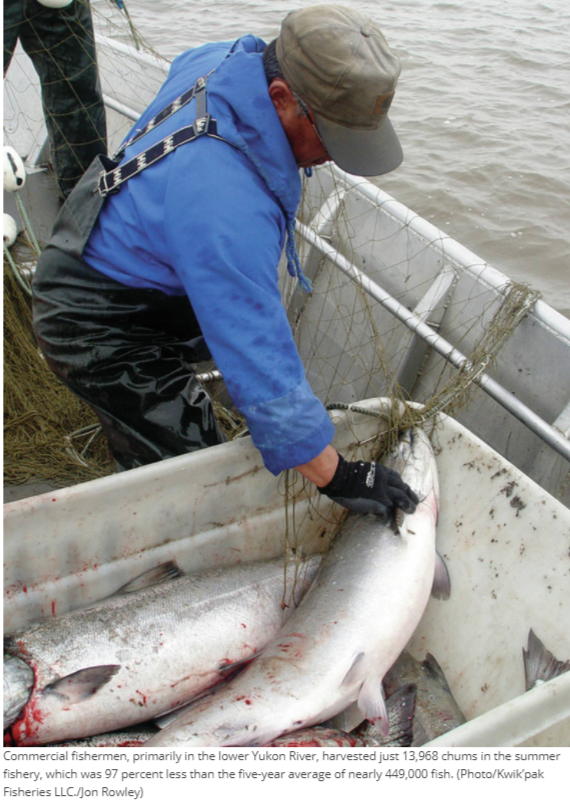
Less than 3% of the usual catch of Chum Salmon were caught in the lower Yukon River this year, the worst in history.
Commercial fishermen, in the lower Yukon, harvested just 13,968 chums in the summer fishery, which was 97 percent less than the five-year average which sees 449,000 fish caught.
Managers had predicted a rather average return of about 1.9 million summer chum, which would have left a harvestable surplus of about 1.1 million fish, according to ADFG. So the total river catch is more like 1% of what was expected.
The latest estimates aren’t just bad, they’re “absolutely dismal,” says Stephanie Quinn-Davidson, director of the Yukon River Inter-Tribal Fish Commission in Alaska.
Every year scientists count fish as they swim up the Yukon River past Eagle, Alaska near the Canadian border, they are nearing the end of life spawning journey. Five years ago they had been swept out to sea in the spring floods as tiny minnows, which in salmon are called smolts.
Those minnows, numbering in the hundreds of millions, made their way south to the vast ocean pastures of the Gulf of Alaska where they have should have spent the last five years being nourished on pastures filled with plankton, their principal food.
This year the upper Yukon River the total chum count is a mere 23,828 fish, none to be caught.
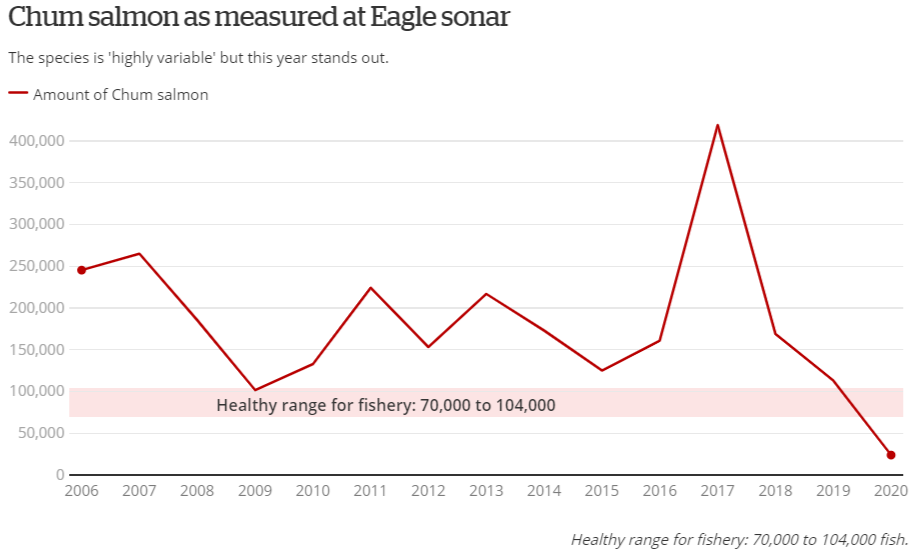
Yukon Chum Salmon run is the lowest in history. The reason for the 2017 peak is because when those baby salmon arrived on their ocean pasture in 2012, instead of mostly starving they were treated to a feast.
This is far below, less than 25%, of the minimum number of fish scientists and management groups, want to see. The ‘spawning escapement goal’, the minimum number of returning fish needed to sustain the salmon requires 100,000 adults.
This year, both the commercial and Indigenous fishery in both Alaska and Canada has been closed. Families will go hungry this winter all along the Yukon River.
This year’s count of chum salmon at Eagle Alaska is only about one-eighth of the average number seen since 2006.
In the last 10 years, chum salmon have been faring better than the King or Chinook salmon that they share the river with. But not this year. The tiny return is said to come as a surprise to many scientists who were not expecting this year’s chum salmon numbers to be at such a catastrophic low.
The Eagle sonar counting station at Eagle, Alaska offers an annual set of data for scientists to review. This year’s numbers for chum are ‘dismal’ says one researcher. (Alaska Department of Fish and Game) Chum populations are known to fluctuate and even have big crashes, but this year’s numbers in the Yukon are the lowest in all of history. With so few spawning adults future years returns will become even more dismal.
But what about that big run of Yukon Chum Salmon shown in the charted data for 2017?
With this year the lowest number of Chum Salmon in history and just a few years ago, 2017, showing the largest number in history what could be the reason. Many fisheries managers and scientists are eager to put forth wild ideas that transfer blame to some unknowable reason or some knowable villains responsible.
At the top of this churlish list of ‘the usual suspects’ lies the fish hatcheries on both sides of the Pacific that bureaucrats looking to shift the blame suggest are responsible for sending too many hatchery grown fish out to sea where they compete with the ‘pure natural’ stocks. But hatchery releases are nothing new, they have been taking place for decades, and there are no exceptional numbers to support them as the blame. It is plain to see something much more fundamental is the blame.
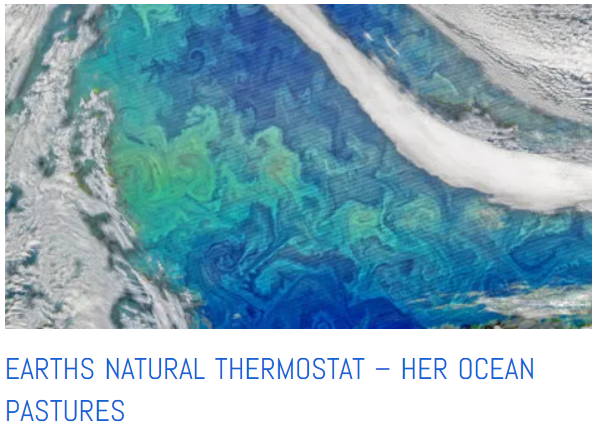
Plankton blooms as seen from space by NASA may appear as art but they also show the way to reduce CO2 and global warming. Click to read more
The second ‘usual suspect’ is an ill-defined but ever-present ‘bogey man’ called climate change. It is true that the oceans are warming, including the North Pacific, but the warming is being seen over the course of decades not a few years. Even if the decline of Chum is correlated to such warming, the warming does not offer a causative mechanism.
There are many other species of salmon and marine fish that share the Gulf of Alaska’s ocean pastures. All are in decline in both numbers and individual size. It is clear that the problem is the carrying capacity of these vital ocean fish pastures. Fisheries management of salmon has never to this day considered the ocean life of salmon as important. They see their only mandate is to manage the ‘catch’ of salmon as they return to the rivers where they spawn. I know this well as for many years I enjoyed the biologist life being able to study returning salmon on government pay with a fishing rod in hand 🙂
Interestingly we can look for part of the answer far to the south to the lesson of the Chum salmon of the Fraser River that enters the Pacific Ocean at Vancouver.
In 2016 the return of Chum Salmon to the British Columbia coastal rivers was the largest in history, a salmon miracle. But on the other side of the Pacific, Japan’s chum salmon failed to survive as their dying ocean pasture and produced the smallest catch in history, a salmon tragedy.
“2016 Fraser River chum salmon return is estimated to be two million, the largest return on record,” said Lara Sloan of Fisheries and Oceans Canada in November of 2016.
“Catches in Johnstone Strait were some of the strongest on record. There have also been very strong returns of chum to the Nanaimo River.” Sloan said the spawning target was met early, with a total catch estimated at 150,000.
Fishermen also reported an astonishing and unexpected bonanza of salmon. Gillnetter Shaun Strobel fishes the west coast of Vancouver Island, and down the Johnstone Strait to Nanaimo.
“The fall net, or chum catch, is usually good”, he said. “But nothing like this.”
The fisheries experts were all totally off on this one.
At first, the Chum salmon return was expected to be so low there was supposed to be a lottery to select a very few fishermen who would be allowed to fish commercially, but returns were so strong fishing was opened up in a free for all for everyone with no limits.
“Everybody was catching fish from the top of the straights up towards Alert Bay all the way down to Campbell River. We were catching fish everywhere,” said Vancouver Island salmon fisherman Shaun Strobel, who described catches of fish weighing down boats and threatening to break or sink nets. “We were all doing the best ever.”
“Although Fraser River sockeye numbers have hit a record low, Chum returning to the Fraser are doing extremely well,” wrote one fishing company’s general manager, Chris Kantowicz.
Kantowicz said the largest catch ever recorded in a Johnstone Strait chum salmon fishery took place Oct. 17 when one fleet pulled in 800,000 fish in a single day.
While fishermen are delighted the Federal Fisheries experts are saying ‘they have no idea’ why the unexpected bonanza of Chum Salmon showed up so utterly against all of their usually reliable projections.
Hmmm… What might have happened with regard to the Chum Salmon last year.
Let’s examine their 4-5 year life cycle and see if there are any clues. Chum salmon, like all salmon, lay their eggs in the gravel in freshwater rivers and streams in the fall of the year. Those eggs incubate over the winter and hatch in the early spring. The tiny Chum alevins emerge from their gravel incubators and are flushed/swim immediately to the ocean.
 Chum are big salmon and they lay vast numbers of eggs, and the eggs are big, this means there are vast numbers of healthy baby Chum hatching each year. No one knows the numbers of young Chum, smolts, that go to sea each spring surely the number is in the hundreds of millions.
Chum are big salmon and they lay vast numbers of eggs, and the eggs are big, this means there are vast numbers of healthy baby Chum hatching each year. No one knows the numbers of young Chum, smolts, that go to sea each spring surely the number is in the hundreds of millions.
Once in the ocean, the young Chum salmon spend as little time in the near-shore coastal waters as possible as that is a region full of all manner of hungry sea-life that love nothing more than baby salmon. The salmon head out into the great North Pacific, the Gulf of Alaska promptly. There they are safer than in coastal waters as there are far fewer predators. But there, they are also at the mercy of the health of their ocean pasture. Chum are primarily plankton feeders, their survival depends on the condition of their ocean pasture. If the pasture is blooming in abundance then the survival rate of the baby Chum salmon is very high and they grow big and strong over the next 4-5 years.
Mostly in recent decades the Chum salmon like so many salmon have a story of doom and gloom as they have simply not been returning from their ocean pastures. The ocean pastures of the North Pacific have been in a multi-decade history of worsening collapse and without a healthy ocean pasture the health and abundance of the ‘livestock’, aka salmon, the pasture can sustain have plummeted.
On the western shores of the North Pacific, the Japanese catch of Chum salmon in 2016 was the worst in history!! Those western Pacific Chum’s ocean pasture had not been restored as was the pasture in the eastern Pacific. Click to read more.
Our CO2 is Killing Ocean Pastures, but perhaps not in the way you might think.
Ocean pastures are in cataclysmic decline in the North Pacific and indeed in every ocean of the world. The reason is not about the usual suspects, those big bad villains the overfishing folks or climate change. The reason is just a little bit of bad behaviour of each of us, but there are a lot of us 7.4 billion and counting. Our CO2 emissions are killing ocean pastures in a very easy to understand manner.
CO2 is today high and rising in the global air, and that’s indisputable. Humanity has in all of our yesterday’s of the fossil fuel age already spewed about a trillion tonnes of Yesterday’s CO2 into the air. We’re busy now working on spewing another trillion tonnes of the noxious plant food into the air that’s Tomorrow’s CO2. That CO2 as we all know feeds plant life which powered by the sun and photosynthesis helps plants grow and spits back oxygen into the air. How great is that you say, we all need to breathe oxygen.
But here’s the problem for the oceans. This is a blue planet as 72% is oceans, of the remaining 28% it’s not all land as about half that 28% is ice and rock where nothing grows. Of the part where plants grow more than half is actually grass, not trees. So what is happening is that as our CO2 is helping plants on land grow, and let’s focus on the grass how can that harm the oceans.
Where plants on land live in mineral soil and live or die depending on whether nature delivers vital rain we all know that when the rain doesn’t fall the grass dies off, but when the rain does fall the grass grows green and bushier. Well CO2 gives plants the ability to survive with far less rain! Hence our present world’s high CO2 has resulted in a vast amount of extra grass growing, its called ‘global greening.’ You can read all about that on this blog.
OK Plants on land need rain but CO2 lets them grow better with less rain. Stick with me.
Plants in the ocean, you know the 72% of this planet that is blue, actually, it is healthy when it is blue-green. Those plants live in water and what they need most is something that blows to them as the rain does for plants on pastures on land. Ocean pastures need dust in the wind. They have all the water they could ever use but they have no minerals.
Here’s the crux of the CO2 problem that grows more grass on land.
MORE GRASS GROWING MEANS LESS DUST BLOWING
Increasing grass, aka ground cover, is starving the ocean pastures to death due to loss of dust.
Back to our story of the twin miracles of Chum Salmon of 2016 and 2017
Did something happen in the North Pacific Chum Salmon pastures that helped the baby Chum salmon that came back last year as adults? No mystery there!
In the summer of 2012 just when the gazillions of baby Chum Salmon went out to sea to begin their 4-5 years of grazing on their ocean pasture their pasture miraculously came back to life as a result of the greatest ocean pasture restoration project in the history of ocean and fisheries science. Proof of this is that the work of a scant dozen earnest shipmates, my crew, and our work to replenish vital mineral dust to the salmon pasture returned the largest salmon runs in history in perfect correlation with that work being ‘good shepherds’ for the ocean pasture.
Do the math for the Chum Salmon, just count from 2012-2013, that’s their 1st. year; 2013-2014, that’s 2 years, 2014-2015, that’s 3 years, and 2015-2016, that’s 4 years and the magic number for the southern Chum Salmon who are known for just that life-cycle! Chum Salmon miracle mystery solved, it was an intended miracle and it just worked.
Feeling skeptical? The miracle of the 2016 and 2017 Chum salmon are not the only salmon miracles!
In 2013, the year following my Gulf of Alaska ocean pasture restoration work the Pink Salmon of Alaska made up an even greater salmon miracle. Pink Salmon live for only two years. So let’s do the life cycle math. The Pink salmon that were eggs in the gravel of rivers and streams along the North American Pacific coast and hatched into baby salmon in the spring of 2012, like their cousins the Chum Salmon were swept and swam out to their vast ocean pasture that spring.
There instead of finding their ocean pasture was a desolate blue desert unable to sustain them they found it had been made into a restored Garden of Eden. Instead of mostly dying they grew and grew and before too long they swam back to their home rivers and streams healthy and strong. That swim home took place in the year 2013, remember Pinks live just 2 years so count em up the year 2012 is year one for the
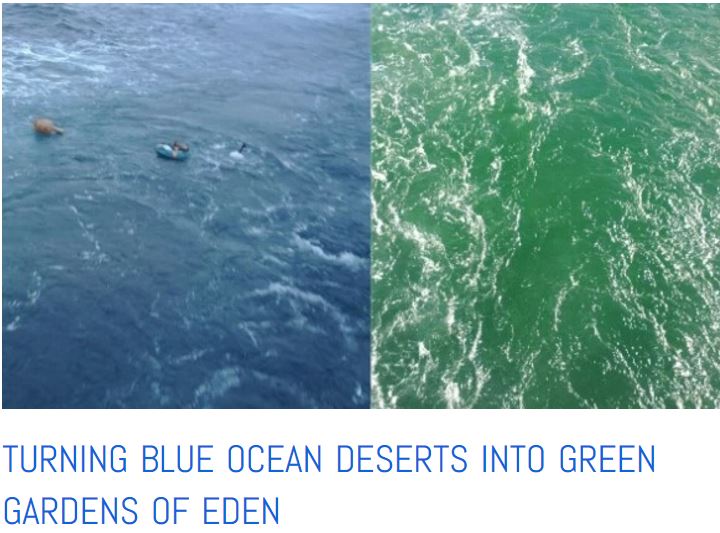
Before and After! Looking astern off the transom of my research ship before we began our dusting to restore the ocean to health the ocean was a blue desert. After dusting the same view revealed a beautiful emerald-green see that had become full of life. (No Photoshop, raw camera) – click to read more
Pinks, the year 2013 is year two for the Pinks.
In Alaska, in 2013 the fisheries experts were confident within 5%-10% certainty that the catch of Pink Salmon would be between 50-52 million of the silver beauties. The experts were dumbfounded when the fishers caught not 50 million Pinks but 226 million of the silver beauties more than 4 times the number expected, the largest catch of salmon in all of Alaskan history. All up and down the Pacific coast reports came in of very stream no matter how small in Pink Salmon territory being absolutely jammed with spawning Pink Salmon. Surely many hundreds of millions of additional Pinks.
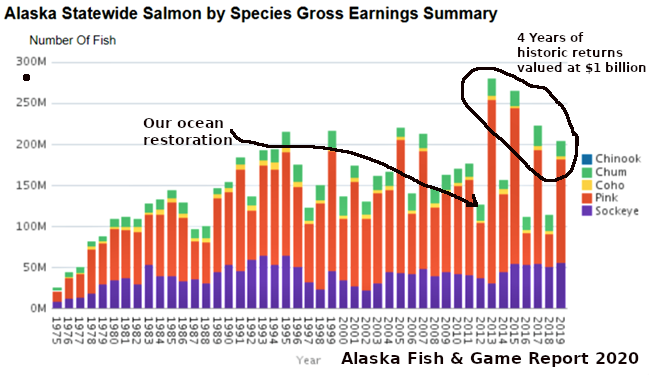
The arrow points to our ocean pasture restoration work in 2012. Note the repeating historic Pink Salmon returns in Alaska. Nearly a billion additional, unexpected fish caught, delivering hundreds of millions of economic stimulus into the Alaska economy.
My 2012 ocean pasture restoration project worked so well it brought back record salmon returns To Alaska the very next year and many years thereafter.
What’s next?
Restore ocean fish pastures everywhere and bring back billions of fish, salmon, cod, tuna, mackerel, and more… enough fish to help end world hunger! And save the planet at a cost of mere millions neither billions nor trillions as the sales folk of climate change would have the world spend.
Join me. Lend a hand. Offer some ideas.









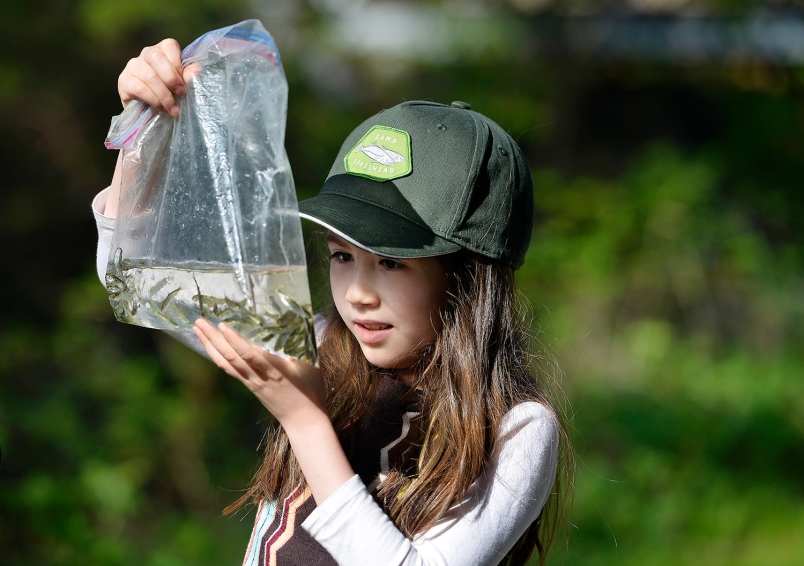
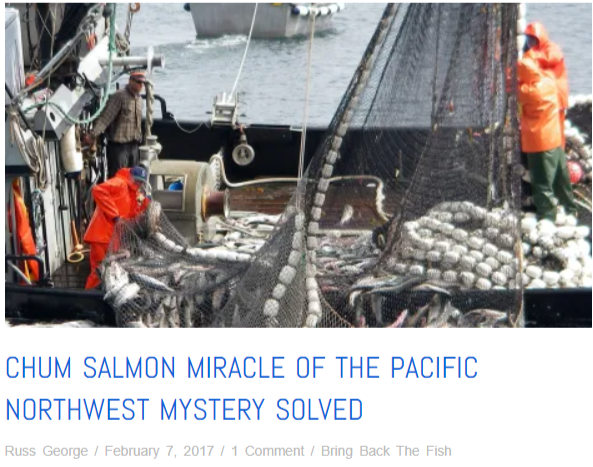
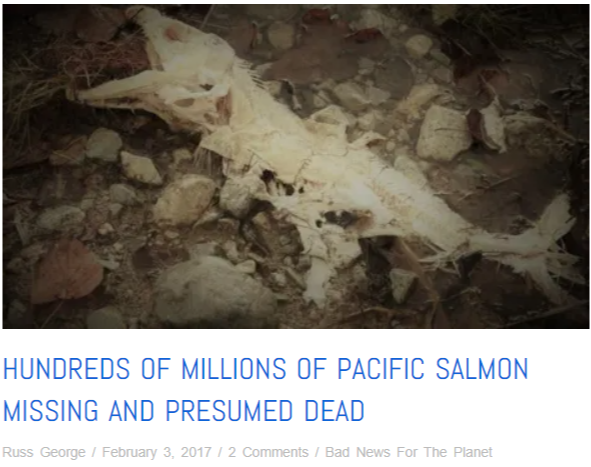


I’ve been following you for a few years now and find your arguments compelling. However, when I reach out to the ocean conservation community they don’t seem to deny your research but quibble over a lack of environmental studies to look at “all the effects” It seems they have locked themselves into analysis paralysis. Has anyone taken on a comprehensive look at the restored fish pastures to rule out any harmful effects. On the surface your proposed project appears to be efficacious and without much delatory effect.
With such a huge return on investment, it is surprising that fishing communities aren’t gathering in secret to proactively manage their ocean pastures.